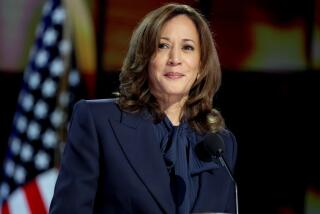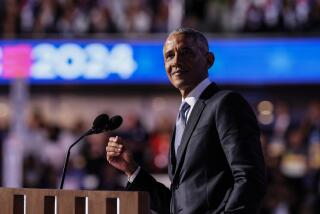Opinion: Can Ellison or Perez save the Democratic Party from itself?

Things were looking rosy for Democrats at their national convention in July. Now? Not so much.
Just a few short months ago, the Democratic Party was licking its chops at the prospect of Hillary Clinton in the White House, Democrats controlling the U.S. Senate, and a Republican Party dissolving into soul-searching anguish after losing a shot at an open White House by nominating Donald J. Trump — whose ascension exposed an existential political/cultural divide within the GOP.
And now we have the exact opposite situation — a Democratic Party shut out of national power as it does its own bit of soul-searching, a process that will play out in the fight for a new chair to replace Rep. Debbie Wasserman Shultz (D-Fla.), whose fall from party grace last summer over comments revealed in hacked emails now looks, in retrospect, like it was an unrecognized omen.
The problem for the Democrats is that the tide is moving against them. Clinton won the popular vote, as we all know, but Trump ginned up enough support in a handful of battleground states to win the electoral college — a turn of events that surprised even him.
Clinton’s 65.8 million votes were less than the 69.5 million that Barack Obama won in 2008 — the last time there was a presidential race without an incumbent running — and slightly less than the 65.9 million that he received in his 2012 reelection. And that’s despite increases in the pool of eligible voters from 213.3 million in 2008, to 222.5 million in 2012, to 231.6 million this year — a 9% expansion of eligible voters.
So as the national pool of voters grew, votes for Democratic presidential candidates declined. But national voter support for the GOP candidates has increased. Trump won more votes nationally (63 million) than Mitt Romney in 2012 (with 60.9 million), and than Sen. John McCain (R-Ariz.) in 2008 (with 59.9 million).
Yes, it’s the electoral college that ultimately matters, and this year, that was Clinton’s to lose — which she did for a variety of reasons. Ultimately, though, she and the Democratic Party were unable to turn around that erosion in support — particularly in crucial states such as Michigan, where Clinton received fewer votes than Obama did four years ago. Massive turnouts in California are nice for the national numbers, but that is essentially running up the score in a game you already won. What Clinton needed was more effective work in Michigan and other battleground states.
But the key to the 2016 results lies in class, gender and racial splits. Clinton had much less support among white men than did Obama, and picked up smaller percentages of the African American and Latino vote. While Clinton prevailed among voters with college educations, Trump cleaned up with those without a college degree, which was, as Pew Research noted, “by far the widest gap in support among college graduates and non-college graduates in exit polls dating back to 1980.”
The Democrats need to focus on expanding the party’s appeal to those who have spurned it.
So who will the Democrats pick to fix that? Rep. Keith Ellison, a progressive from Minnesota who made history as the first Muslim elected to Congress, was the early favorite (and backed by Bernie Sanders), but Labor Secretary Tom Perez has also jumped in, with the support of Obama and others in the administration. (There are a handful of other candidates, but none has picked up much traction.)
Both contenders, interestingly are from the progressive part of the party. Perez, the son of Dominican immigrants, grew up in blue-collar Buffalo, N.Y., is pro-union, and headed up the Justice Department’s Civil Rights Division before Obama tapped him to run the Labor Department. Perez’s election would send a strong signal to the nation’s growing Latino population and reassure labor.
Electing Ellison, who is black, would send a similar message to African American and Muslim voters, and could give the party a poignant figure to put up against whatever Trump winds up doing with his campaign pledges to target Muslims for tighter security scrutiny.
And both Perez and Ellison, a Detroit native who moved to Minneapolis to attend law school, are seen as capable organizers, the kind of skill that will be necessary to rebuild the party.
But the Democrats need to focus on expanding the party’s appeal to those who have spurned it — people with lesser educations, particularly white males — while energizing (and not losing) their traditional supporters. Can Perez or Ellison put together a game plan to do that? That’s the question.
If the next couple of years play out the way many on the left fear they will — attacks on civil liberties, dismantling of environmental protections, repeal of the Affordable Care Act, undercutting public education, rollbacks of Wall Street regulations — the Trump administration could provide the Democrats with a golden opportunity.
The party just needs to find a way to not squander it by continuing with the same visions, organizational strategies and policies that so many voters have greeted with yawns.
Twitter: @smartelle
More to Read
A cure for the common opinion
Get thought-provoking perspectives with our weekly newsletter.
You may occasionally receive promotional content from the Los Angeles Times.











